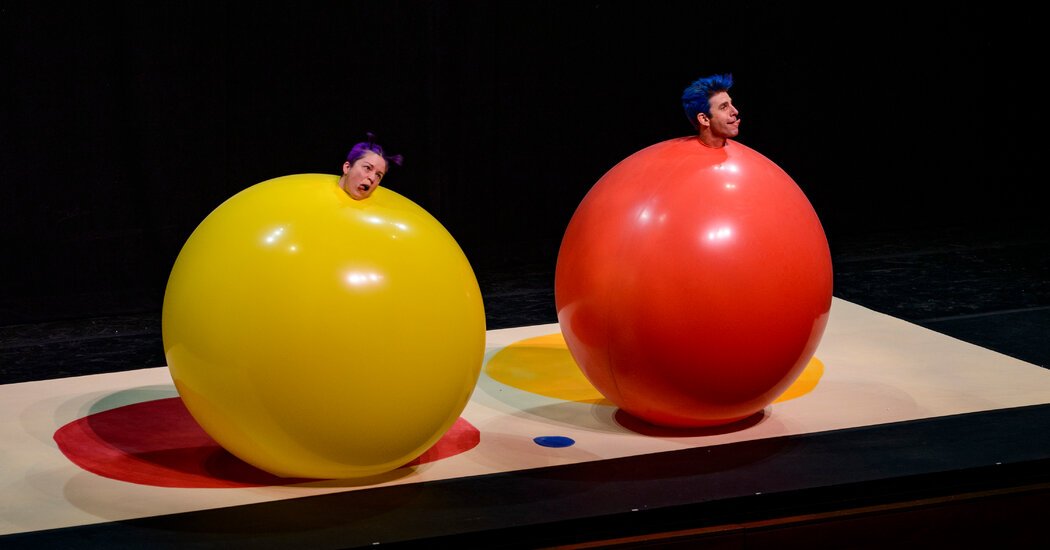
Seth Bloom, a blue-haired clown and physical comedy virtuoso who helped outreach organizations in Afghanistan and other remote places stage circuses that roused smiles from children while also teaching them important life skills, like how to avoid land mines, died on Aug. 2 in Poughkeepsie, N.Y. He was 49.
He died by suicide, said his wife, Christina Gelsone, with whom he performed in two-person clown shows around the world, including at the Big Apple Circus in New York City.
Based in Harlem, the duo, who performed as the Acrobuffos, were renowned for “Air Play,” a wordless one-hour show for children and families featuring balloons, giant swatches of silk and Styrofoam packing peanuts that floated around the theater.
Like his purple-haired wife, Mr. Bloom renounced garden-variety clown props — floppy shoes, honking horns, rubber chickens — for artistic comedy that blended physical tomfoolery with music and expressions of curiosity, wonder and love.
“Seth was like a jazz musician of physical comedy and clowning,” said David Kilpatrick, the director of education at the John F. Kennedy Center for the Performing Arts in Washington, which staged “Air Play” two years ago in one of its largest theaters. “He was clearly an extraordinary artist who leaned into a kind of connective, communal laughter that was really transformative.”
Mr. Bloom’s career, and his relationship with Ms. Gelsone, began in one of the world’s most humorless and unromantic places: Afghanistan in 2003, during the aftermath of the United States’ overthrow of the Taliban.
“Two clowns meet in Afghanistan — it sounds like a joke,” Mr. Bloom often said.
Mr. Bloom, who had studied at the Ringling Bros. and Barnum & Bailey Clown College, traveled there on the recommendation of his mother, an international aid worker. She had heard about an organization, the Mobile Mini Circus for Children, that was trying to stage educational clown shows in remote areas of the country. Ms. Gelsone was in Kabul, the Afghan capital, doing similar outreach for Bond Street Theater, a New York company.
“We wanted to make a circus, but we had no background in this,” David Mason, the founder of the Mobile Mini Circus for Children, said in an interview. “We got some equipment together, like juggling clubs. We tried our best, but we had bruises all over our bodies because we were throwing the clubs, and they were beating us on the head and nose and body.”
Mr. Bloom taught the group how to use clown equipment (safely) and helped Mr. Mason craft scripts and costumes that entertained children and taught them about the dangers that surrounded them. A script about malaria explained the proper use of bed nets. Another one taught children how to freeze if they walked near an area that might have land mines.
“The country is stark and beautiful,” Mr. Bloom told The Widow Stanton, a circus blog. “I was going to areas that no media was going to, and no one was taking positive pictures of kids laughing and mullahs laughing and old guys with donkey carts pulling up to watch our shows.”
He saw himself as helping to rebuild the country in ways that many aid organizations and politicians had overlooked. His work there made him an early pioneer of the social circus movement, in which clowns entertain and educate children in the world’s most troubled places.
“Hospitals and infrastructure are part of what’s needed,” he told The New York Times in 2009. “But people need to be people. What we do lets kids dream. What we do lets them imagine a future.”
Mr. Bloom and Ms. Gelsone eventually began dating. They returned to Afghanistan for seven straight years, including for their honeymoon after they married in China while performing there in 2007. The bride wore a dress made from hundreds of tiny white balloons.
“It’s not the best place for a honeymoon, in case anyone’s curious,” Mr. Bloom told the Pennsylvania newspaper The Morning Call. “Most often you’re sleeping in rooms with other people.”
The original scripts that Mr. Bloom helped create are still being used in Afghanistan. Mr. Mason said that at least 4.3 million children have seen the shows. Mr. Bloom and his wife also started a program in Egypt for Darfur refugees and children living on the streets, as well as teaching social circus in Mexico, Chile, Taiwan and other places.
“Seth was strong — not only his body, but his voice,” Mr. Mason said. “He knew exactly what he knew and what he wanted us to do. That gave us a kind of security that we were in the right hands, that this guy knows what’s right.”
Seth Allan Bloom was born on Jan. 4, 1975, in Washington. His father, Peter Bloom, was a foreign service office. His mother, Gretchen (Brandow) Bloom, worked for the World Food Program.
Seth grew up around the world — in India, Kenya and Sri Lanka, among other places. He learned to juggle after moving back to Washington for high school.
“When I was applying to college, I saw I could either go to regular college and keep learning English and French and math, or I could go to clown college and learn to throw pies, wear big shoes and fall down,” he told The Widow Stanton. “And I thought that would be fun.”
At age 19, he enrolled at the Ringling clown college, graduating in 1993 with a bachelor’s in fun arts (seriously). He then toured the country as a professional juggler and studied at the Dell’Arte International School of Physical Theater in Northern California. He earned a Bachelor of Arts degree in dance from Wesleyan University in 2000 and a master’s in physical theater from the London International School of Performing Arts in 2005.
His wife used to introduce him at clown workshops as “the most overeducated clown in the world.”
The Acrobuffos act took the couple around the world. For part of “Air Play,” which was probably their biggest hit, they jumped around in giant balloons, with only their heads visible.
“The most important thing we’ve learned about climbing inside balloons is not to fart,” Mr. Bloom once said.
In addition to his wife, Mr. Bloom is survived by his father and his sister, Claire Bloom.
In recent years, Mr. Bloom experienced debilitating foot pain, most likely as a result of performing. After shows, he submerged his feet in ice baths. More than 40 foot specialists examined him, but the pain didn’t react to treatments.
“He had to be so careful onstage,” Ms. Gelsone said. “We would climb in these giant balloons and hop in them, and that was like the worst thing for his feet. And so there would be days where I’d be like, ‘Don’t hop today. I’ll hop twice as high for you.’”
If you are having thoughts of suicide, call or text 988 to reach the 988 Suicide and Crisis Lifeline or go to SpeakingOfSuicide.com/resources for a list of additional resources.





